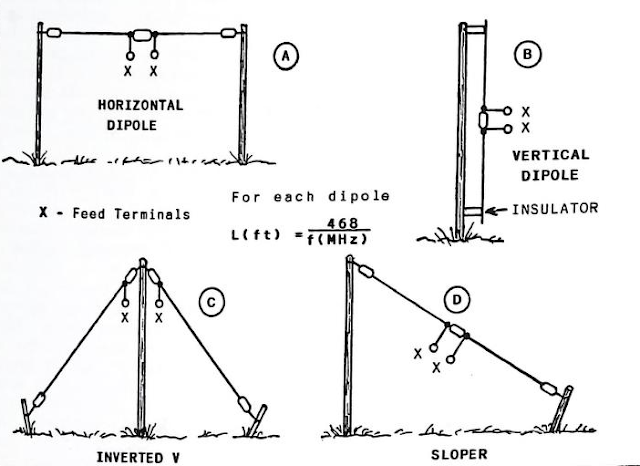Some newcomers are confused about the proper type of conductors to use for antennas. I have been asked, for example, "Can I use wire that has plastic insulation?" Another common inquiry is, "What is the best wire gauge or diameter for my dipole?"
Still another question is, "Which is best? Stranded or solid wire?"
These are good questions, and I fault no one for asking them. Consider the first question. After all, insulation is used to confine ac and dc voltage in circuit wiring. This prevents unwanted short circuits, and the insulation protects us from electrical shock. Therefore, it is reasonable for a beginner to assume that RF (radio-frequency) energy cannot be radiated through the insulation.
Actually, this insulating layer has little effect on the radiation of an antenna. It will, however, slow down the passage of RF energy at the higher frequencies, such as VHF and UHF signals. It introduces what is known as a propagation or velocity factor. When this happens we must shorten the wire slightly to compensate for the velocity factor. At HF (high frequency), the effects of insulation are so minor that we can ignore them.
The thinner the insulating material on wire, the better. This is because insulation adds to the weight of the wire, and we may have a problem supporting an insulated-wire antenna because of its weight. It may sag or cause the support masts to bow or break. It is for this reason that most amateurs use bare stranded no. 14 copper wire for antennas. Others prefer enameled single-conductor wire. The insulation is beneficial because it prevents the copper conductor from becom- ing corroded in the presence of contaminants in the air. This enameled wire will, however, break more readily from flexing in the wind than will stranded copper wire of the same gauge.
Furthermore, soft-drawn single-conductor copper wire will stretch with time, and this will change the resonant frequency of the antenna (move it lower in frequency). For this reason you should make certain that you purchase hard-drawn copper wire.
A stronger type of wire is available. It is known as Copper- weld (TM), to signify that it has a steel core with a copper coating. It is difficult to work with because it is quite springy and hard to manage. It is very rugged wire, and it should stay aloft for years. You should avoid kinking it during handling. Avoid sharp bends in the wire also. Kinking and radical bending ruptures the copper covering, and this allows moisture and pollutants to reach the steel core.
This will, in time, cause the wire to break.
Wire gauges 12 and 14 are the most popular among amateurs. These sizes offer good strength, cross-sectional area and acceptable weight. This does not mean that you can't use other gauges of wire. I have used 130-foot spans of no. 26 enameled wire for "invisible" end-fed antennas.
The systems worked fine, but needed to be replaced frequently from breakage. I have also used no. 8 solid copper wire (heavy!) for dipoles and end-fed antennas. The larger the wire diameter the lower the antenna Q (quality factor).
This won't degrade the antenna performance. Rather, the lower the Q the greater the antenna bandwidth. For example, an 80-meter dipole made from no. 18 wire might have an SWR bandwidth (frequency between the 2:1 SWR points) of, say, 50 kHz. The same antenna, if made from no. 10 copper wire, might have a 75-kHz SWR bandwidth.
Vinyl-covered electrical house wiring is entirely suitable for building antennas, but it is quite heavy. I do not use it for long horizontal spans. I find that it is OK for use in inverted-V and similar antennas that have drooping elements. The vinyl covering adds strength, and this can be helpful if you live in an area where high wind and ice storms are frequent.
Many types of commonly available wire may be used for building antennas. For example, I have made a variety of antennas from no. 18 insulated speaker wire. I split the two conductors, which can be pulled apart easily.
This gives me twice as many feet of wire per roll than before the separation is done. Electric fence wire is used by a number of amateurs. It is very inexpensive, and comes in no. 18 Copperweld or aluminum materials, Checkwith your area farm-supply store, or Sears, for this and other suitable wire.
Some beam antennas and verticals can be made from common items that may be found locally. Commercial antennas of this kind are fashioned from aluminum tubing of a specified tensile strength and hardness. This material is not only hard to find, but it is expensive. You may prefer to make your small beam antenna or vertical from thin-wall electrical conduit. The antenna will be heavier than if aluminum were used, and it will eventually become rusty unless you paint the metal.
I have made a number of vertical antennas from copper tubins that I purchased at a plumbing-supply store. The 1/2- or 3/4 inch copper tubing may be supported on standoff insulatore that are attached to a wooden mast. I have also employed thin wall electrical conduit for the conductor of a vertical antenne Aluminum downspout (gutter) sections may be joined to form a guyed vertical antenna for 40 meters and higher. I know a ham operator who has access to used irrigation pipe.
He made a lovely guyed, 80-meter vertical from this stock.
It is important that you be innovative when selecting material for your homemade antennas. Not only will you save money, you will be able to acquire the components quickly. Although iron is not as ideal a conductor as aluminum or copper, it will perform well for medium- and high-frequency operation.
source : Novis Antenna Notebook by Doug DeMaw, W1FB


